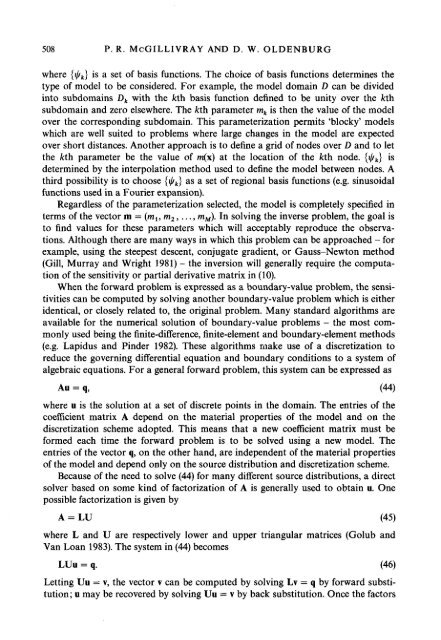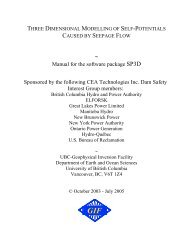METHODS FOR CALCULATING FRÃCHET DERIVATIVES AND ...
METHODS FOR CALCULATING FRÃCHET DERIVATIVES AND ...
METHODS FOR CALCULATING FRÃCHET DERIVATIVES AND ...
Create successful ePaper yourself
Turn your PDF publications into a flip-book with our unique Google optimized e-Paper software.
508 P. R. McGILLIVRAY <strong>AND</strong> D. W. OLDENBURGwhere {$k} is a set of basis functions. The choice of basis functions determines thetype of model to be considered. For example, the model domain D can be dividedinto subdomains Dk with the kth basis function defined to be unity over the kthsubdomain and zero elsewhere. The kth parameter mk is then the value of the modelover the corresponding subdomain. This parameterization permits ‘blocky’ modelswhich are well suited to problems where large changes in the model are expectedover short distances. Another approach is to define a grid of nodes over D and to letthe kth parameter be the value of m(x) at the location of the kth node. {!),’I isdetermined by the interpolation method used to define the model between nodes. Athird possibility is to choose {$k} as a set of regional basis functions (e.g. sinusoidalfunctions used in a Fourier expansion).Regardless of the parameterization selected, the model is completely specified interms of the vector m = (mi, m, ,..., mM). In solving the inverse problem, the goal isto find values for these parameters which will acceptably reproduce the observations.Although there are many ways in which this problem can be approached - forexample, using the steepest descent, conjugate gradient, or Gauss-Newton method(Gill, Murray and Wright 1981) - the inversion will generally require the computationof the sensitivity or partial derivative matrix in (10).When the forward problem is expressed as a boundary-value problem, the sensitivitiescan be computed by solving another boundary-value problem which is eitheridentical, or closely related to, the original problem. Many standard algorithms areavailable for the numerical solution of boundary-value problems - the most commonlyused being the finite-difference, finite-element and boundary-element methods(e.g. Lapidus and Pinder 1982). These algorithms make use of a discretization toreduce the governing differential equation and boundary conditions to a system ofalgebraic equations. For a general forward problem, this system can be expressed asAU = q, (44)where U is the solution at a set of discrete points in the domain. The entries of thecoefficient matrix A depend on the material properties of the model and on thediscretization scheme adopted. This means that a new coefficient matrix must beformed each time the forward problem is to be solved using a new model. Theentries of the vector q, on the other hand, are independent of the material propertiesof the model and depend only on the source distribution and discretization scheme.Because of the need to solve (44) for many different source distributions, a directsolver based on some kind of factorization of A is generally used to obtain U. Onepossible factorization is given byA=LU (45)where L and U are respectively lower and upper triangular matrices (Golub andVan Loan 1983). The system in (44) becomesLUU = q. (46)Letting Uu = v, the vector v can be computed by solving Lv = q by forward substitution;U may be recovered by solving Uu = v by back substitution. Once the factors



